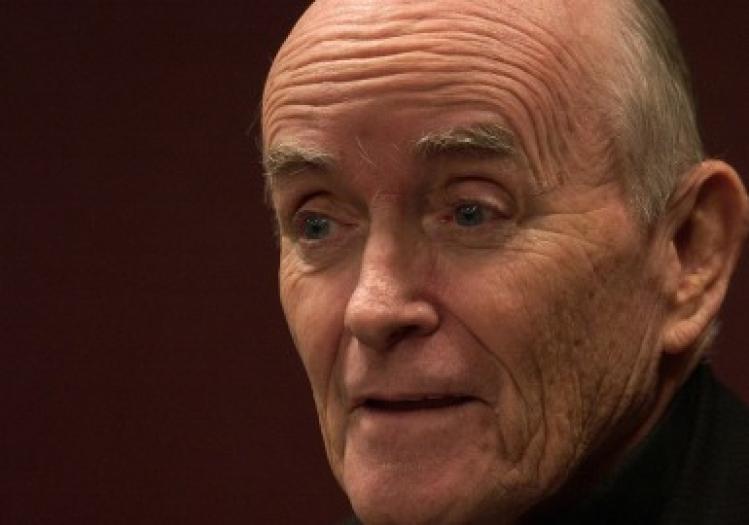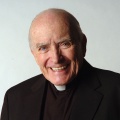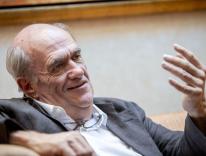
Over the course of six decades, Fr. Andrew M. Greeley—who died on May 30—wrote regularly for Commonweal. Following are excerpts from just some of his articles, the first of which here originally appeared in 1959, and the last in 2008. Follow the links to read the complete archived versions.
From “The Suburban Parish,” September 1959 (.pdf):
[One] characteristic of the suburban parish is that, like the suburb of which it is a part, it is child-centered. It is very much to be feared that the Catholic suburbanite thinks of his parish primarily as a place for his children. Here they are to be educated—not just in religion, but in all the social graces, dancing included. Here they are to receive their instructions about sex. Here they are to have their recreation and their athletic programs. Here they can be sent to get them out of their mother's hair for five hours each day. Here is where the blame is to be assigned if they act up or do not get good grades. Here is the place for a good part of their social life when they become teen-agers. …
At least one serious religious difficulty comes from the very fact that a parish is in the suburbs; like the suburb it tends to become isolated from many aspects of life. In a steel-mill parish the economic problems of the day are self-evident. In a racially changing neighborhood, the problems of the migrant groups are obvious. In a slum neighborhood, the implications of metropolitan development are not to be denied. In a university parish the intellectual currents of the age cannot very well be ignored. But the ordinary suburban parish is so concerned with its own problems of growth and so busy building up its own tight little community that it is not the best platform for social action in the world of human activities and ideas. For the husbands and fathers this is particularly true. They spend so few of their waking hours within the parish boundaries that they are apt to think of the parish as a place for their women and children, with little to contribute to the important decisions of life. No one has yet discovered an effective way of linking the suburban parish with the larger economic and social questions of the day.
 From “Catholic Campuses: The Place of Religion,” April 1966 (.pdf):
From “Catholic Campuses: The Place of Religion,” April 1966 (.pdf):
A Catholic campus is not only a locus for scientific and artistic instruction; it is also a place where a community of Christians have come together to enter into an established pattern of relations. It is a segment of the pilgrim people of God gathered together for a dialogue which is essentially intellectual. The intellectual dialogue may be only marginally affected by the fact that those engaged in it (faculty, administration, and students) are members of the pilgrim people. But by the very fact that they share communion with Christ through the Holy Spirit their relationship will tend to transcend the merely intellectual and become one of Christian love; I say "transcend," not "replace" or "distort" or "substitute for.” …
The most important element in any Christian community is its worship. Indeed if the liturgy is not enacted with dignity and inspiration, then there is reason for grave doubt as to how Christian the rest of the life of the community will be. On recent visits to Catholic colleges, I have observed that on many the Mass is "available," i.e., it is offered frequently and usually hastily with the bare minimum of changes authorized by the Constitution on the Liturgy. There is a notable lack of enthusiasm and even of understanding for the new liturgy, coupled with a regret that the old compulsory Mass attendance rule became so unpopular that it had to be dropped. Often it seems that the liturgical revival consists essentially of having noon and evening masses and turning the altar around. Restrictions imposed by some chancery offices make it difficult in certain colleges to do even those things permitted by the liturgical constitution and by the American bishops; whatever restrictions may be deemed necessary elsewhere in the diocese, diocesan officials ought to recognize that the campus community is a special one with special needs.
Finally, we note that the campus liturgy seems to involve only students; rarely do faculty, lay or clerical, participate in community worship together with the students-save at the compulsory Mass of the Holy Spirit at the beginning of the school year. The paternalistic ethos is still among many Catholic educators. When one observes that campus liturgy leaves much to be desired, the reaction is that there ought to be periodic community Masses to which everyone will be obliged to come. But religious compulsion simply does not belong on the campus. What is required is that divine worship become an exciting, dynamic event in the life of the Christian community on campus; if this happens then voluntary attendance will increase rapidly; if it does not happen, forced attendance will not obscure the community’s failure at that which is most essential. It seems to me that a campus which, on the one hand, enforces an elaborate system of rules and insists on compulsory retreats and, on the other, has an insipid liturgy really does not understand what the Catholic Church is all about.
From “What Catholics Do Well,” April 1999 (.pdf):
Catholic colleges have, by and large, remained Catholic despite frequent attempts to make them less Catholic. The young people who attend them still report the Catholic atmosphere: They still like the liturgy, they are still more likely to do volunteer service than students at other colleges, and they still want their children to go to the college they attend. Catholic parents and Catholic students still find something Catholic in the schools or they would not pay for them. Indeed those faculty types who want to eliminate Catholicity from the schools completely (and fight attempts to restore it) fail to realize that if they were successful, they would be out of their jobs. As long as the student body is heavily Catholic and much of the faculty is Catholic and a religious order is somehow involved, and the buildings are the same and a tradition (like a chapel) lurks in the corridors, a school will continue to be Catholic, perhaps in spite of itself. Mandates from a bishop can't improve that or even affect it. Indeed a mandate from a bishop and a dollar-and-a-half in Chicago will get you a ride on Rich Daley's subway.
 From a remembrance of the writer J. F. Powers, July 1999 (.pdf):
From a remembrance of the writer J. F. Powers, July 1999 (.pdf):
Powers is a Catholic storyteller not merely because he wrote about priests or about midwestern Catholicism but because he was acutely aware of the presence of grace and cared deeply about the salvation of his characters (as do his colleague at Saint John's University Jon Hassler and the English novelist David Lodge). Even his character Urban, shallow ecclesiastical operator that he is, cannot escape the transforming touch of grace. …
How, it was often asked, did Powers know so much about priests? He must have lived in a rectory, it was suggested. Or perhaps priests who were his friends told him tales out of school. My guess is that his priests were creatures of a vivid, sympathetic, and unerring imagination, and that Powers worked with bits and pieces of clerical everyday life that he would pick up, as it were, on the fly. Moreover, around Saint John's there were plenty of pieces to pick up. Powers had us down cold and was perhaps too kind to us. However, he wanted us, like Urban, to be touched by grace.
Some say that Powers lost touch with the clergy of the years after Vatican II. I disagree. His final stories captured perfectly the effort of men trying to convince themselves that nothing had really changed when in fact everything had changed.
From “A Cloak of Many Colors: The End of Beige Catholicism,” November 2001 (.pdf):
Catholics are different. We belong to a sacramental church and hence are a sacramental people, distinct from those who are less sacramental than we are. Since Vatican II, however, a type of false prophecy--based on an illegitimate reading of the council-- has suggested that Catholics abandon these differences and become "just like everyone else."
Such a mélange would not be Catholicism. Any cultural heritage is a tool kit, a set of paradigms that suggests attitudes and responses to the problems and opportunities of life. Usually, such a heritage is subconscious and unreflective, which makes the problem of defining and describing it complex. Here I will try to examine contemporary Catholic attitudes and responses, especially toward what we have traditionally called the sacramentals.
Priest and theologian Robert Baron, born in 1960, says that he was raised and educated in what he calls "beige Catholicism," a Catholicism stripped of much of its beauty, its rainforest of metaphors, denuded in an effort to be "just like everyone else." Beige Catholicism is somehow trapped between the solemn but empty rituals of the past and a bare-bones, low-church Protestantism--not quite Catholic but not really Protestant either.
The issue is not restoration. The Catholicism of the forties and fifties cannot and should not be restored. Rather, the issue is whether the church, in its haste to adjust to the post-conciliar world, jettisoned much of what was distinctive and precious in the Catholic sacramental heritage.
From “Information Deficit,” July 2004:
To a relative Vatican outsider like myself, the church’s need for organizational change seems self-evident. Yet few bishops are ready to consider a drastic reform of the church’s internal operations. They do not comprehend that decision making is shaped by the information available to the decision makers, and that, in the absence of good information, serious mistakes are made. …
Many in Rome and elsewhere in the Catholic world contend that the church does not need social science because it has the Holy Spirit. Hence the tools of management science are not relevant. Nor, because of its divine origin, does the church need to apply to itself its own principle of subsidiarity (nothing should be done at a higher and larger level that can be done at a lower and smaller level). Such reasoning, based on simplistic faith and even more simplistic theology (or a calculating one), in effect regards the church as purely divine and thus unaffected by the problems that beset other human institutions. Don’t worry about the poverty of leadership, pious folk (including cardinals) tell me, God will not desert his church. (Does that also mean God was responsible for all the errors and mistakes the church has made?) Yet all that was promised to the church by Jesus was survival—the gates of hell will not prevail against it.
Whether this erroneous perspective is based on naive piety or (deliberately) bad theology does not matter. It must be dismissed out of hand, for the church is subject to the same organizational dynamics as other human institutions. If the church is to function effectively it needs to follow the same principles of subsidiarity any other human institution must. Subsidiarity opens the way for the maximum input from the Spirit. There may be some sense in which subsidiarity does not apply to the church, but there must be some sense in which it does-at least when it comes to organizational management. …
From “The Puzzling Pope,” a review of David Gibson’s Who is Benedict XVI? The Rule of Benedict, October 2006:
…American Catholics are not divided between, say, First Things and Commonweal. (Alas, most U.S. Catholics have heard of neither.) While there have been some losses to the church in the last several decades, it seems impossible to drive out most of the laity, no matter how much the leadership tries. At every level—pope, curia, diocese, parish—the leadership does not understand the faith and the spiritual depth of its people. Hence the laity become an inkblot onto which those in power can project their personal opinions and biases. Social research might be a help, but who needs social research?
In a similar vein of empiricism, I would hope (perhaps foolishly) that as the pope and his colleagues ponder a long-term strategy for winning Europe back to the faith—a contest for which the church has enormous resources, if it would only recognize them—they might postpone faulting the laity for the decline of faith and reifying abstractions such as secularism, materialism, relativism, Marxism. Instead, they might begin, in prayerful and humble examinations of conscience, to wonder how they themselves or their predecessors might have contributed to the loss of Europe (should it really be lost). They might even ask quietly, “What have we done wrong?”
 From “Signs of Life,” August 2008:
From “Signs of Life,” August 2008:
By way of setting the assumptions: Don’t expect real reform in the Catholic Church until the Roman curia is brought under control of local bishops. Vatican II was the most successful reform council in Catholic history—until the world’s bishops left Rome and the curia took control again. Now we hear that the council didn’t change a thing but was merely an exercise in continuity.
Unfortunately, the leadership that should have guided the energies released by the council elected to suppress them, and the Spirit has been forced to rely on the lower clergy and the laity to restructure the church. None of us will live to see an authentic post–Vatican II church emerge. … Still, there are signs of the times on the horizon, no bigger than the size of a man’s hand, that suggest enormous vitality in Catholicism and give grounds for hope. …
Catholics have become more tolerant of homosexuals. In 1973, the first year of the National Opinion Research Center’s General Social Survey, 76 percent of Protestants and 71percent of Catholics asserted that homosexual sex was always wrong. In 2007, the percentages had declined to 65 percent and 47 percent, respectively. Much of this change, like most change of attitudes, is not the result of individuals changing their minds but of cohort replacement-younger respondents replace those who have died. Thus, in the cohort born before 1910, 86 percent thought that homosexual sex was always wrong, while in the cohort born after 1980, the rate has fallen to 38 percent. …
Volunteer movements, strong among Catholics, touch on the essence of Catholicism: serving the least of one’s brothers and sisters. In parishes with an intelligent, emotionally secure pastor, volunteers abound—ministers of welcome (ushers), ministers to the sick, lectors, cantors, Eucharistic ministers, youth ministers, CCD teachers, sports ministers, parish and financial council members, school-board members, and parish trustees—there are scores of parishioners eager to assume responsibility for needed activities. …
Despite the church’s lack of interest in teenagers and young people, the enthusiasm of young Catholics in some of the new movements is a remarkable, if underappreciated, phenomenon. By “new movements” I do not mean Opus Dei or the Legionaries of Christ but groups that have grown up around some of the religious orders, such as the Jesuit Volunteers, the Vincentian Volunteers, the Claretian Volunteers, Amate House, and Notre Dame’s Alliance for Catholic Education (ACE) program. …
Many fallen-away Catholics are merely waiting for invitations to return. My research in the Archdiocese of Chicago suggests there are some four hundred thousand “fallen away” Catholics. About half have left because of a mixed marriage. The other half have left because of the “other” issues—authority, sex, or a conflicted family background. Nearly half admit to occasional thoughts about returning, and 17 percent say that they think of it “sometimes” or “often.” Thus, there are roughly sixty-eight thousand “fallen-aways” in Cook and Lake Counties who might be open to invitations to return, and sixteen thousand who could be just waiting for an invitation. I know of no organized effort in Chicago to reclaim these lost sheep. In my parish in Tucson, the monsignor has been running a series for Alienated Catholics Anonymous for almost two decades. He presides over three series a year, and estimates that perhaps six hundred people have “come home to stay” since the program began. …
[These] suggest that something new and exciting is aborning. I look back on my eight decades with hope and, yes, delight.
Please email comments to [email protected] and join the conversation on our Facebook page.
Share
Previous Story
Kim Jong-il's Sushi Chef
Next Story
Featured on the homepage
